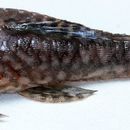en
names in breadcrumbs


Corymbophanes és un gènere de peixos pertanyent a la família dels loricàrids.[3]
Viuen entre troncs submergits i sobre fons de grava i còdols.[4]
Es troben a Sud-amèrica: Corymbophanes andersoni viu aigües amunt de les cascades Kaieteur (riu Potaro, conca del riu Essequibo)[7] i Corymbophanes kaiei a la conca superior del riu Potaro (conca del riu Essequibo).[8]
Corymbophanes és un gènere de peixos pertanyent a la família dels loricàrids.
Corymbophanes is a genus of armored catfish native to South America where they are only known from Guyana. Corymbophanes was originally placed in its own tribe Corymbophanini, but the first comprehensive molecular phylogenetic analysis of the subfamily Hypostominae found Corymbophanes to be nested within the tribe Ancistrini.[1]
Corymbophanes and its type species, C. andersoni, were first described in 1909 by Carl H. Eigenmann.[2] In 2000, they were redescribed along with the description of a new species, C. kaiei.[3] In 2004, the tribe Corymbophanini was erected.[4]
Corymbophanes represents an old lineage as it lacks many of the characteristics of the rest of the subfamily Hypostominae. This group probably has a basal position within the subfamily.[3]
There were previously two recognized species in this genus.[5] A third species was described in a 2020 study.[6]
Corymbophanes species originate from the upper Potaro River of the Essequibo River drainage system. C. andersoni is only known from the Chenapou Falls of this river. C. kaiei is only known from the Oung Creek, a small tributary of the Potaro River drainage. Neither of these species are found downstream of the Kaieteur Falls.[3] Corymbophanes species live in swift riffles over gravel and cobble and among submerged logs.[3]
Like other Loricariids, Corymbophanes species have plates of armor on their body and a suckermouth. Small odontodes are also present along their body.[3] This genus can be distinguished from all other Loricariids by the presences of a dorsal ridge formed by plates between the dorsal fin and the caudal fin, the absence of the adipose fin, as well as the absence of the omega iris that most loricariids possess.[3] Corymbophanes species do not have evertible cheek plates and do not hypertrophied cheek odontodes which are present in many other loricariid species, which differentiates it from the few species that possess the aforementioned ridge.[4]
Species of this genus do not get very large; C. andersoni does not exceed 8.6 centimetres (3.4 in) and C. kaiei does not exceed 6.6 cm (2.6 in).[2][7] These fish are dark brown to black with white or cream-colored markings.[3] C. kaiei has alternating light and dark bands on its caudal fin; also, this species has a dark-colored abdomen with light vermiculations in adults. By contrast, C. andersoni has no bands on the caudal fin, has no vermiculations, and the abdomen is light-colored.[3]
Corymbophanes is a genus of armored catfish native to South America where they are only known from Guyana. Corymbophanes was originally placed in its own tribe Corymbophanini, but the first comprehensive molecular phylogenetic analysis of the subfamily Hypostominae found Corymbophanes to be nested within the tribe Ancistrini.
Corymbophanes es un género de peces perteneciente a la familia de los loricáridos.[2]
Viven entre troncos submergidos y sobre fondos de grava y guijarros.
Se encuentran en Sudamérica: Corymbophanes andersoni vive aguas arriba de las cascadas Kaieteur (río Potaro, cuenca del río Esequibo) y Corymbophanes kaiei en la cuenca superior del río Potaro (cuenca del río Esequibo).
Corymbophanes es un género de peces perteneciente a la familia de los loricáridos.
Corymbophanes is een geslacht van straalvinnige vissen uit de familie van de harnasmeervallen (Loricariidae).
Corymbophanes is een geslacht van straalvinnige vissen uit de familie van de harnasmeervallen (Loricariidae).
Corymbophanes – rodzaj słodkowodnych ryb sumokształtnych z rodziny zbrojnikowatych (Loricariidae). Spotykane w hodowlach akwariowych. Zaliczane do glonojadów.
Gatunki endemiczne dopływów rzeki Essequibo w Gujanie[2][3].
Gatunki zaliczane do tego rodzaju[4]:
Gatunkiem typowym jest Corymbophanes andersoni.
Jonathan Armbruster opracował klucz do identyfikacji gatunków[3].
Corymbophanes – rodzaj słodkowodnych ryb sumokształtnych z rodziny zbrojnikowatych (Loricariidae). Spotykane w hodowlach akwariowych. Zaliczane do glonojadów.
Загальна довжина представників цього роду коливається від 6,6 до 8,5 см. Голова масивна, вкрита кістковими пластинками. Очі невеличкі, на відміну від інших представників родини позбавлені райдужної облонки. Одонтоди (шкіряні шипи) на щоках невелички. Губи мають сосочки. Тулуб кремезний масивний, звужується в хвостовій частині. Його вкрито зверху кістковими пластинками. Уздовж тулуба відсутні пластини. Спинний та анальний плавці мають 1-2 дорстких променя. Спинний плавець з короткою основою. Спинний хребт утворено пластинами між спинним плавцем і хвостовимо плавцем. Жировий плавець відсутній. Грудні плавці великі та довгі, черевні — короткі й широкі. Хвостовий плавець короткий, цільний.
Забарвлення темно-коричневого або чорного кольору з білими або кремовими плямочками. Черево може бути світліше, а на плавцях — світлі смуги.
Це демерсальні риби. Зустрічаються в прозорих, швидких водах та гравійно-кам'янистих ґрунтах. Територіальні риби. Активні у присмерку. Живляться дрібними водними організмами, яких всмоктують ротом.
Є ендеміка Гаяни. Мешкають в басейні річок Ессекуібо і Потаро.